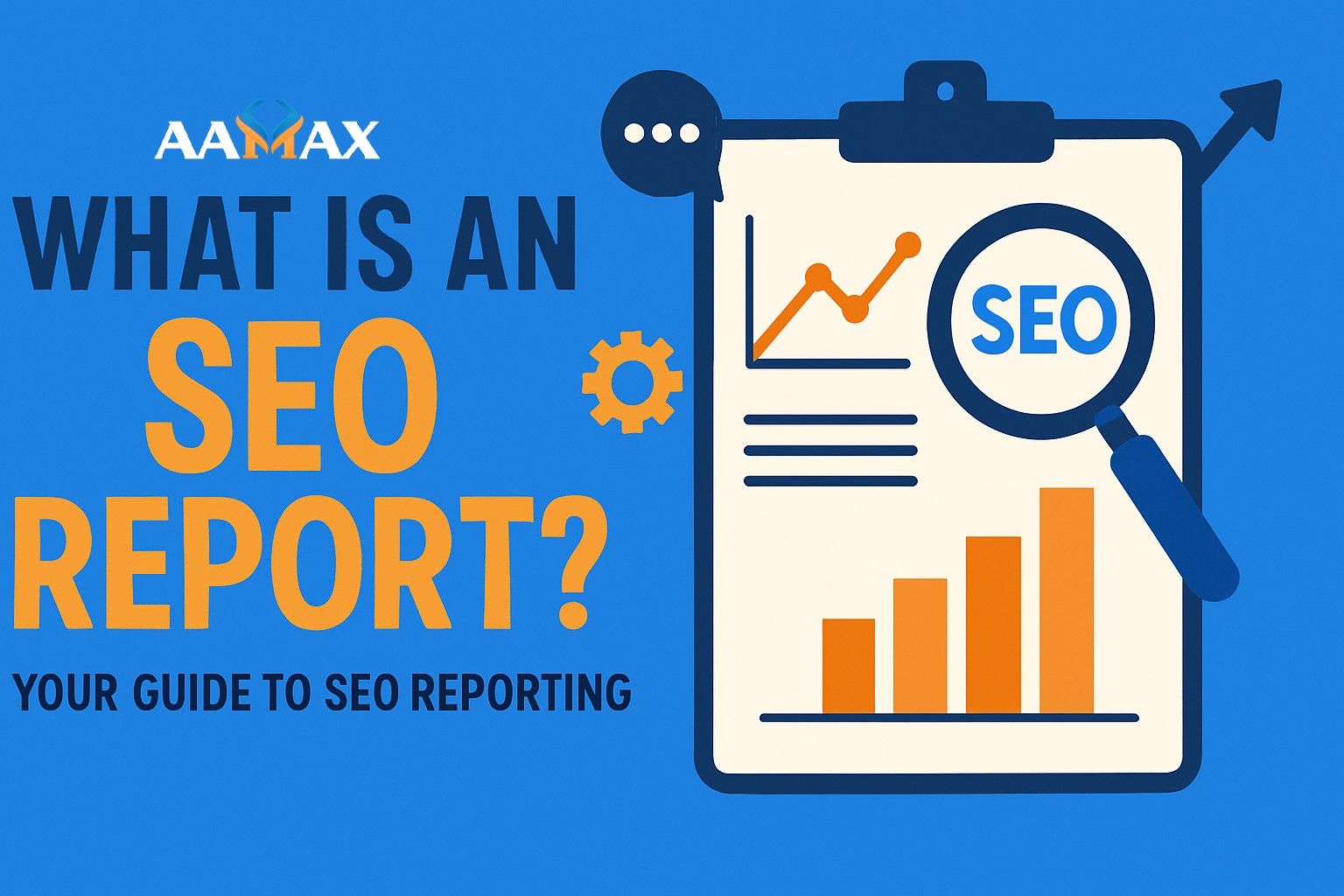
What Is an SEO Report? Your Guide to SEO Reporting
If you have ever invested in search engine optimization (SEO), you know that results are not immediate. SEO is a long-term strategy that requires continuous analysis, adjustments, and improvements. But how do you measure progress and prove that your SEO efforts are actually working? That’s where an SEO report comes in.
An SEO report is more than just numbers and charts—it’s a roadmap that explains how your website is performing in search engines, what’s working, what’s not, and where to focus your digital marketing efforts next. In this guide, we’ll walk you through everything you need to know about SEO reporting, what should be included in an Search Engine Optimization (SEO) report, why it matters, and how businesses can use it to make informed decisions.
What Is an SEO Report?
An SEO report is a document that provides detailed insights into how your website is performing in organic search. It summarizes key metrics such as keyword rankings, organic traffic, backlinks, conversions, and technical health.
Think of it as the performance dashboard for your SEO campaign. The report translates complex data into actionable insights, helping business owners, marketers, and SEO specialists understand what strategies are paying off and what areas need more attention.
A good SEO report should not just show data—it should tell a story. For example:
- How has your organic traffic improved over the past month?
- Which keywords are driving the most traffic?
- Are your backlinks growing steadily?
- Is your technical SEO holding your site back?
By answering these questions, an SEO report becomes an essential tool for improving online visibility and ROI.
Why Are SEO Reports Important?
SEO reports are crucial for several reasons:
-
Measuring ROI
Businesses invest money and resources into SEO. An SEO report shows whether the investment is delivering results in terms of rankings, leads, and revenue. -
Tracking Progress
SEO is a long-term process. Regular reporting makes it easy to see improvements month-over-month and year-over-year. -
Identifying Issues Early
A drop in rankings or technical issues can significantly impact traffic. Reports help identify problems before they become major setbacks. -
Transparency in Client Reporting
For digital marketing agencies, SEO reports provide clients with transparency and accountability. It shows what actions were taken and the outcomes achieved. -
Guiding Future Strategy
SEO reports provide insights that guide future campaigns—what to double down on, what to fix, and where new opportunities lie.
Key Components of an SEO Report
Not all SEO reports are created equal. A strong SEO report includes a mix of metrics, analysis, and recommendations. Below are the core sections every SEO report should cover:
1. Executive Summary
The executive summary gives a high-level overview of the report. It explains the main takeaways, such as:
- Growth in organic traffic
- Key keyword ranking improvements
- Any significant drops or challenges
- Next steps for the campaign
This section is especially useful for business owners and decision-makers who may not have time to dive deep into every detail.
2. Organic Traffic Overview
Traffic is the lifeblood of SEO. This section shows:
- Total organic visits over the reporting period
- Comparison with the previous period (month-over-month or year-over-year)
- Top-performing landing pages
- Traffic by device (desktop vs. mobile)
Google Analytics or GA4 data is typically used to provide these insights.
3. Keyword Rankings
Keyword rankings indicate where your site stands in search engine results. This section should include:
- Current ranking positions for target keywords
- Ranking changes compared to previous periods
- Keywords moving into the top 10 positions
- Opportunities for new keywords
Ranking data helps identify which pages need optimization and which are driving the most visibility.
4. On-Page SEO Metrics
On-Page SEO optimization is crucial for SEO success. This section may include:
- Meta titles and descriptions performance
- Page speed and Core Web Vitals
- Internal linking improvements
- Content updates and engagement metrics
These insights highlight how well your site is optimized for user experience and search engines.
5. Backlink Profile
Backlinks are one of the most important ranking factors. This section reports on:
- Number of new backlinks acquired
- Quality and authority of linking domains
- Lost backlinks
- Anchor text distribution
A healthy backlink profile indicates growing authority and trust in your industry.
6. Technical SEO Health
Even the best content won’t rank if your site has technical issues. This section often includes:
- Crawl errors and indexation issues
- Mobile-friendliness
- Site speed performance
- Broken links or 404 errors
- XML sitemap status
Tools like Google Search Console, Screaming Frog, or SEMrush can be used to generate this data.
7. Conversions and Goals
At the end of the day, traffic alone doesn’t pay the bills—conversions do. This section should track:
- Leads generated from organic search
- Sales attributed to SEO traffic
- Goal completions (form fills, downloads, sign-ups)
- Conversion rates over time
This ties SEO efforts directly to business outcomes.
8. Recommendations
An SEO report should never just present numbers—it should suggest actionable next steps. For example:
- Optimize specific pages for keywords on page two of Google
- Improve site speed for mobile users
- Build backlinks for underperforming service pages
- Update old blog content for freshness
These recommendations ensure the report drives continuous improvement.
How Often Should You Create an SEO Report?
The frequency of SEO reporting depends on the project and client expectations. Common intervals include:
- Monthly Reports – Most standard for businesses, as SEO results are more noticeable over weeks rather than days.
- Quarterly Reports – Useful for high-level executives who prefer strategic overviews.
- Weekly Reports – Helpful during critical campaigns or when monitoring specific issues closely.
Monthly SEO reports are the most popular since they balance detailed tracking with manageable reporting cycles.
What Makes a Good SEO Report?
A strong SEO report should have the following qualities:
- Clarity – Easy-to-read charts, graphs, and explanations.
- Relevance – Only include metrics that matter to the business goals.
- Actionability – Provide clear next steps based on the data.
- Consistency – Use the same format each month for easier comparisons.
- Customization – Tailored to the client or business goals, not a generic template.
Tools for Creating SEO Reports
There are many tools available for building comprehensive SEO reports. Some popular ones include:
- Google Analytics / GA4 – For organic traffic and conversion data.
- Google Search Console – For keyword performance and indexing issues.
- SEMrush / Ahrefs / Moz – For backlink analysis and keyword rankings.
- Screaming Frog – For technical SEO audits.
- Data Studio (Looker Studio) – For custom visual dashboards.
Most businesses use a combination of these tools to create a full picture of their SEO performance.
Common Mistakes in SEO Reporting
While SEO reports are invaluable, many are poorly done. Common mistakes include:
- Overloading with too much data without context
- Ignoring conversions and only reporting traffic
- Using complex jargon clients don’t understand
- Failing to compare current performance with previous periods
- Not tying results to business goals
Avoiding these mistakes ensures your SEO reports are impactful and easy to understand.
The Future of SEO Reporting
As search engines evolve, so does SEO reporting. Some trends shaping the future include:
- AI-Powered Insights – Tools using AI to highlight anomalies and suggest actions automatically.
- Voice Search Tracking – Measuring performance for conversational queries.
- User Experience Metrics – Increased importance of Core Web Vitals in reports.
- Integrated Marketing Reports – Combining SEO with paid ads, social media, and content marketing metrics for a holistic view.
Businesses that adapt their reporting strategies will stay ahead in the competitive digital landscape.
How Businesses Can Use SEO Reports
SEO reports are not just for marketing teams—they’re valuable business tools. Here’s how companies can leverage them:
- Decision-Making: Invest more in content marketing, link building, or technical fixes based on data.
- Budget Allocation: Justify SEO budget increases with proof of ROI.
- Client Reporting: Agencies can build trust and long-term relationships with transparent reporting.
- Performance Benchmarking: Compare results against competitors and industry benchmarks.
Partner with Experts for Effective SEO Reporting
While tools and templates are widely available, creating a meaningful SEO report requires expertise. Understanding what metrics to prioritize, how to interpret them, and how to turn insights into action is not always straightforward.
That’s where partnering with a full-service digital marketing company can make a difference. If you’re looking for professional help with SEO reporting, web development, or digital marketing, consider working with AAMAX. AAMAX offers comprehensive solutions including Web Development, Digital Marketing, and SEO Services—helping businesses not only generate reports but also achieve measurable growth from them.
Conclusion
An SEO report is more than just a document—it’s a strategic tool for improving search visibility, driving traffic, and generating conversions. By focusing on the right metrics, avoiding common mistakes, and using professional expertise, businesses can transform SEO data into powerful decision-making insights.
Whether you’re an in-house marketer, a business owner, or working with an agency, remember: a great SEO report doesn’t just show what happened—it shows what to do next. And that is the real value of SEO reporting.







